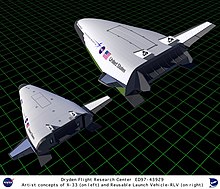X-33

RS-2200 aerospike engine test (2001)
|
X-33 is the name of a scaled-down unmanned prototype for a successor to the space shuttle projected by Lockheed Martin , which was called the "Venture Star". The aim was to create a completely reusable space shuttle that would take off vertically with the help of innovative aerospike engines, reach orbit in one stage and then land again like an airplane.
Development history
Project definition
On July 2, 1996, NASA selected Lockheed Martin Skunk Works to design and build the X-33, a prototype and test vehicle for new technologies. In addition, Rockwell and McDonnell Douglas had made offers. The X-33 was part of the Reusable Launch Vehicle Program (RLV, program for the development of a reusable spacecraft) that also included the DC-X (Delta Clipper) and the X-34 and laid the foundations for the construction of a new, should create inexpensive operable spaceship. Future spaceships should be able to be prepared for the next flight "within a few days instead of months" and the launch costs should be reduced to a tenth of what was then 10,000 US dollars / pound.
X-33 should perform test flights in the earth's atmosphere at speeds of up to Mach 15 and altitudes of over 70 kilometers. They were supposed to be driven by two XRS-2200 linear aerospike engines developed by Rocketdyne . Liquid oxygen and liquid hydrogen (O 2 (l) + H 2 (l) or LOX / LH2) served as fuel . Both were to be carried in internal tanks made of fiber composite material in a honeycomb core sandwich construction, which was also a new development and was to become the decisive point when the project was discontinued.
The heat shield should be made of a novel metallic material, which should make it safer and cheaper than the ceramic shield of the space shuttle, which incurred enormous maintenance costs.
Development of the prototype
At the beginning of 1997, wind tunnel tests in a 0.56 m helium wind tunnel (22 inch) were reported. In it, small X-33 models about 15 centimeters in size were tested under conditions that correspond to Mach 20.
In 1998 flight tests were carried out with a model. A remote-controlled unmanned aircraft was used as the carrier aircraft for the drop
On September 29, 2000, NASA announced in a press release that the X-33 was 75% complete and 90% of all parts had been produced.
Construction of the launch facilities
On November 14, 1997 the foundation stone was laid for the launch system of the X-33 at Edwards Air Force Base (Area 1-54). At that time, 15 test flights were planned from July 1999. The launch systems included, among other things, a swivel device for erecting the aircraft, a retractable hangar, tank systems and flame trenches. The control center should be set up in an existing room on the site. The Michael Army Air Field of the Dugway Proving Grounds / Utah and the Malmstrom Air Force Base / Montana were planned as runways .
End of program
Due to problems in development and production, the Venture Star program and with it the 85% completed X-33 was officially abandoned by NASA on March 1, 2001. Originally the hydrogen tanks were supposed to be made of fiber composite material, but this caused massive problems. At the suggestion of the engineers to manufacture the tanks from aluminum as for the predecessors and for the oxygen tank of the Venture Star, the then NASA director Ivan Bekey responded with a speech by the relevant committees of the House of Representatives that the main reason for the X-33 was to "combine and test new technologies", which is why they did not approve any money for this solution. The solution to prevent the composite tanks from bursting with steel belts would have required a completely new development of the VentureStar due to the significantly higher weight compared to the original design and the aluminum tanks, which exceeded the budget, whereupon the project was discontinued. On the other hand, the development of the new aerospike engine was largely successful, and a launch pad for the X-33 was built at Edwards Air Force Base . In total, NASA invested $ 912 million and Lockheed Martin $ 357 million by the time the X-33 program was discontinued. About half of this went into the development of the XRS-2200 engine.
X-33 in science fiction literature
- In Dan Brown's novel Angels & Demons a prototype is Boeing used X-33, a speed of Mach can reach 15 and in an hour from Boston to Geneva flying.
See also
Web links
- waffenhq.de: Lockheed Martin X-33
- heise.de: Space transporter X-33
- NASA: Photos of the X-33 program (English)
Individual evidence
- ↑ NASA - X-33 fact sheet. Retrieved July 29, 2018 .
- ↑ a b c X33 History Project Fact Sheet # 3. NASA History Division, September 23, 1998, accessed January 13, 2019 .
- ↑ X-33 Wind Tunnel Testing Continues at NASA Langley Research Center. A composite model of the X-33 is tested in NASA Langley's 22-Inch Mach 20 Helium Tunnel. NASA News Photo Release 97-004, January 21, 1997, accessed January 13, 2019 .
- ↑ X-33 air drop model - takeoff with mothership. Photo Number: EC98-44814-8. NASA, 1998, accessed January 12, 2019 .
- ↑ NASA, LOCKHEED MARTIN AGREE ON X-33 PLAN. NASA press release 00-157. NASA, September 29, 2000, accessed January 13, 2019 .
- ^ X-33 Launch Complex (Area 1-54). (PDF) (No longer available online.) USAF, archived from original on June 5, 2011 ; accessed on June 30, 2011 (English).
- ↑ X-33 LAUNCH FACILITY GROUNDBREAKING HERO. NASA News Release 97-266. November 14, 1997, accessed January 13, 2019 .
- ↑ X-33 / VentureStar - What really happened - NASASpaceFlight.com. Retrieved July 29, 2018 (American English).


